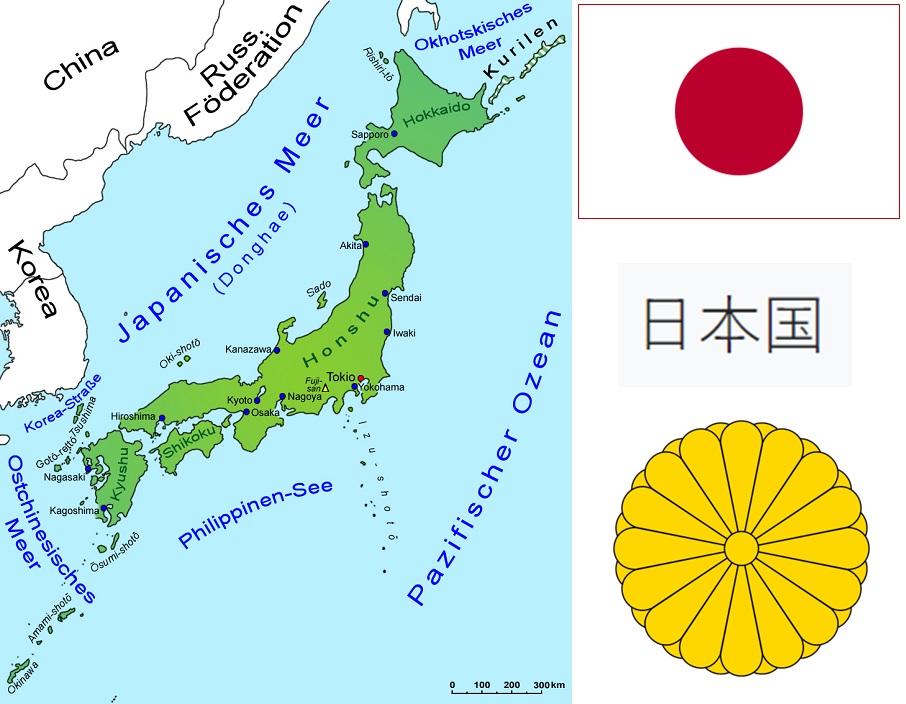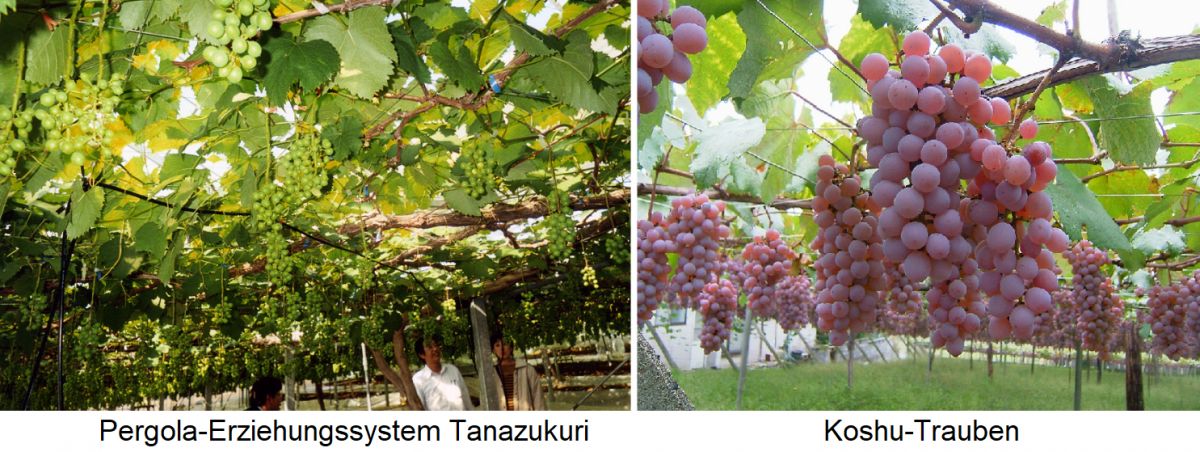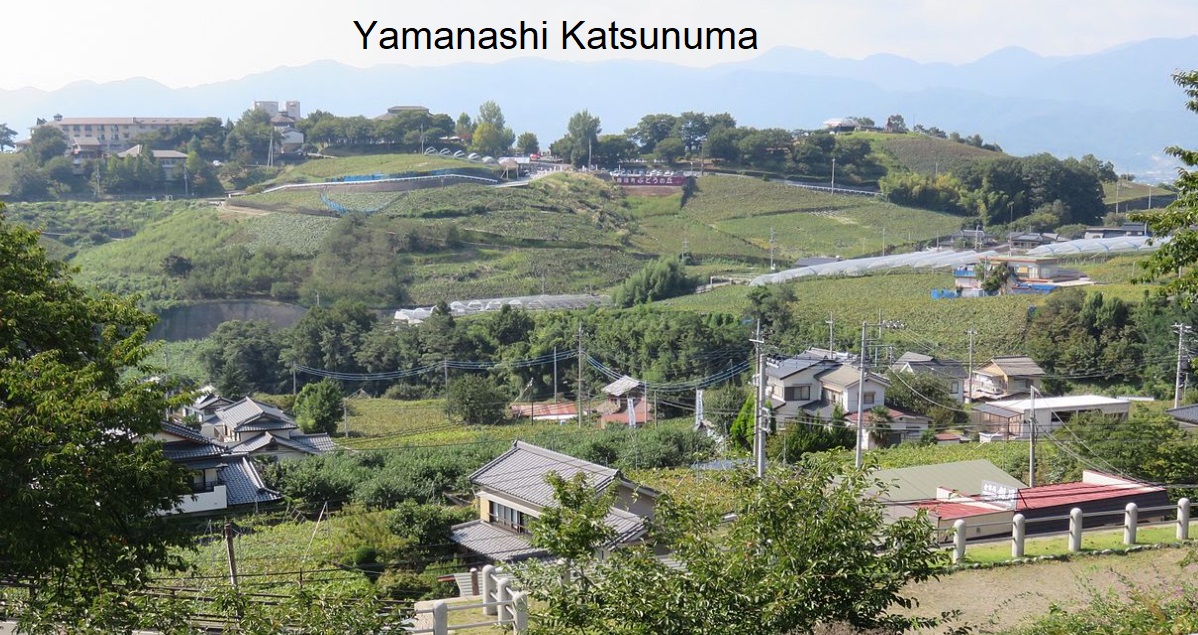The parliamentary monarchy of Japan (日本, Nippon in Japanese) with its capital Tokyo in East Asia covers 377,975 km². It consists of 14,125 islands in the Pacific Ocean and is indirectly bordered by Russia to the north and north-west, North Korea and South Korea to the west and Taiwan and China to the south-west. The five main islands are Hokkaidō (78,420 km²) in the north, the central and largest island of Honshū (227,942 km²), followed to the south by the islands of Shikoku (18,297 km²) and Kyūshū (36,782 km²) as well as the small island of Okinawa (1,208 km²) further south. To the north is the Korea Strait, to the west the East China Sea, to the south the Pacific Ocean and to the east the Seto Inland Sea.

History
According to legend, in 718 in Katsunuma (Yamanashi on the main island of Honshu), Saint Gyoki planted vines given to him by the Buddha Nyorai and built the Daizenji Temple. In honour of the Buddha, Gyoki created a statue called Budo Yakushi (Budo = wine, Yakushi = teacher of medicine), which still stands in the temple today. Wine has long been regarded as a healing medicine in Japan. Yamanashi is still the wine-growing centre of Japan today, with around 30 modern production facilities. Buddhist monks spread vines throughout the country, but the wines were mainly used as a carrier for medicines or for the production of sultanas. Many wild vines of the Asian species Vitis coignetiae still grow on trees in Japan today. They are only suitable for viticulture to a limited extent, but a red wine made from the Yama Budou variety was even exported to Europe during the phylloxera catastrophe.

The Koshu variety shown in the picture was allegedly discovered at the foot of Mount Fujiyama around 1186 and is still the most popular variety in Japan today. However, as it is a species of Vitis vinifera, this theory is unlikely. In the 16th century, Portuguese Jesuit missionaries brought red wine (tintashu) as a gift. In 1569, the shogun Oda Nobunaga organised a much-praised wine festival for his samurai commanders. At the beginning of the 17th century, the pergola-like vine training Tanazukuri, which is still in use today, was introduced, in which the vines are trained to a man's height and the shoots are guided like a roof up to ten metres to all sides on supporting wires and protected with straw mats in winter. This is intended to prevent rot, which is favoured by the high humidity prevailing here.
Modern viticulture
In the Meiji era (1868-1912), Japan began to open up to Western ideas and techniques, including in viticulture. In 1877, the Dainihon Yamanashi winery was founded, which is considered the forerunner of today's Mercian Katsunuma Winery, the largest producer with a fifth of the volume. A year later, Masanari Takano and Ryuken Tsuchiya were sent to France to learn about viticulture and winemaking. After two years, they returned and applied their knowledge. However, the business was soon closed in 1886.
Attempts were made to produce wine from indigenous varieties, mostly hybrids with Asian genes. The oenologist Zenbē Kawakami (1868-1944) is considered the pioneer and "father of Japanese viticulture", who was able to establish Muscat Bailey A as the first national quality wine variety through decades of systematic cross-breeding. For the first time, foreign grape varieties were allowed to be introduced into Japan. This was the beginning of modern Japanese viticulture. But it was not until after the Second World War that things slowly began to pick up. From 1970, in connection with the World Expo in Japan, a wine boom began, particularly for red wines, to which the French paradox also contributed.
Wine-growing regions
The most important wine-growing regions are Nagano, Okayama, Osaka, Yamagata and Yamanashi (coinciding with the historical province of Kōshū) with the best area Kofu Valley. Although they lie on the same latitude as the Mediterranean, they have a very different climate. There are very cold winters, wet rainy springs and autumns as well as summers with typhoons. The origin of the wines is labelled as "Kokunai san" (domestic wine) or "Yunyu san" (imported bulk wine). However, you cannot necessarily rely on this, as most wines labelled as Japanese (including premium products) are blends of a small proportion of Japanese wine with wines from South America and Eastern Europe.

Grape varieties
American, European and Asian grape varieties are cultivated in Japan. Many of these are hybrids based on the American species Vitis labrusca, because unlike the European flavour, the Japanese are not bothered by foxy. There is still a lot of experimentation with new varieties; some are listed in the table. Sweet white and rosé wines are produced from the Muscat varieties. International varieties are also increasingly being cultivated. In 2021, the vineyards covered 17,738 hectares of vines and the wine production volume was 805,000 hectolitres The majority is used for the production of table grapes. The grape variety chart (Kym Anderson):
Grape variety |
Colour |
Synonyms or Japanese names |
Hectare |
| Koshu | white | Koushuu | 690 |
| Niagara White | white | Yunnanshuijing | 551 |
| Muscat Bailey A | red | - | 521 |
| Concord | red | - | 292 |
| Delaware | white | - | 254 |
| Campbell Early | red | - | 238 |
| Merlot | red | - | 197 |
| Chardonnay | white | - | 137 |
| Kerner | white | - | 76 |
| Kyoho | red | Ju Feng, Kioho, Kyohou | 62 |
| Zweigelt | red | - | 59 |
| Cabernet Sauvignon | red | - | 42 |
| Verdelet | white | - | 39 |
| Portland | white | - | 39 |
| Yama Budou | white | Yamabudo | 35 |
| Black Queen | red | Pokdum | 28 |
| Ryugan | white | Longyan? | 27 |
| Adirondac | red | - | 24 |
| Yama Sauvignon | red | - | 24 |
| Müller-Thurgau | white | - | 22 |
| Cascade | red | 22 | |
| Riesling | white | - | 22 |
| Pinot Noir | red | - | 20 |
| Yamanashi 7 | red | Yamasachi | 20 |
| Sauvignon Blanc | white | - | 15 |
| Riesling Forte | white | - | 2 |
| Rose Ciotat | white | - | 2 |
| Red Millennium | red | - | 2 |
| Cabernet Lion | red | - | ? |
| Cabernet Suntory | red | - | ? |
| Ishihara Wase | red | - | ? |
| Komahikari | white | - | ? |
| Koshu Sanjaku | white | Kosju Sanjaki, Koushuu Sanjaku | ? |
| Koshu Sémillon | white | - | ? |
| Mills | red | - | ? |
| Neo Muscat | white | - | ? |
| Pione | red | - | ? |
| Riesling Lion | white | - | ? |
| Yama Sémillon | white | - | ? |
Producers
In Ikeda in the sub-prefecture of Tokachi on Hokkaidō, the second largest island after Honshū, there is a research institute for wine culture and oenology, which also provides tourists with information on Japanese viticulture and runs its own vineyards. Wine production is dominated by a few huge corporations, most of which obtain their grapes from many small winegrowers who often own no more than half a hectare of vines. The five largest Japanese producers account for around three quarters of total production. Important Japanese wineries include Asahi (Ste Neige), Château Lumière, Grace Wine (Chūō Budōshu), Hirakawa Winery, Manns Wines Katsunuma Winery, Mercian Katsunuma Winery, Sapporo (Polaire) and Suntory (with Tomi-no-Oka Winery). However, despite the existing wine boom, the Japanese national drink is still traditionally sake (rice wine) with a distinct drinking culture.
Map: © Goruma
Flag: by Various, Public domain, Link
Coat of arms: by Philip Nilsson, Public domain, Link
Koshu on the left: By Sophie Jacquin - Own work, CC BY-SA 3.0, Link
Koshu right: By genta_hgr - Grape, CC BY 2.0, Link
Yamanashi Katsunuma: by Aw1805 - Own work, CC BY-SA 4.0, Link
Map: By Alexrk2 - Japan location map,(Chumwa), CC BY-SA 3.0, Link
Voices of our members

The Wine lexicon helps me to keep up to date and refresh my knowledge. Thank you for this Lexicon that will never end in terms of topicality! That's what makes it so exciting to come back often.
Thorsten Rahn
Restaurantleiter, Sommelier, Weindozent und Autor; Dresden